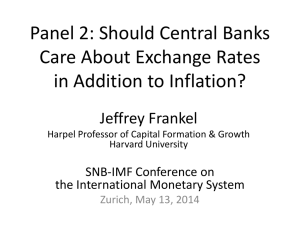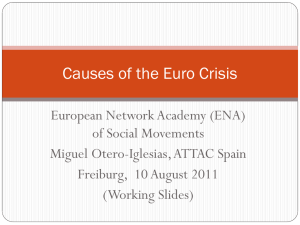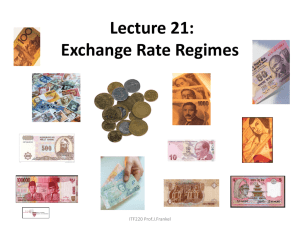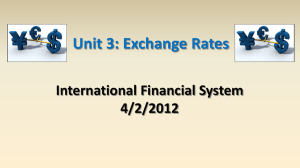L13-14
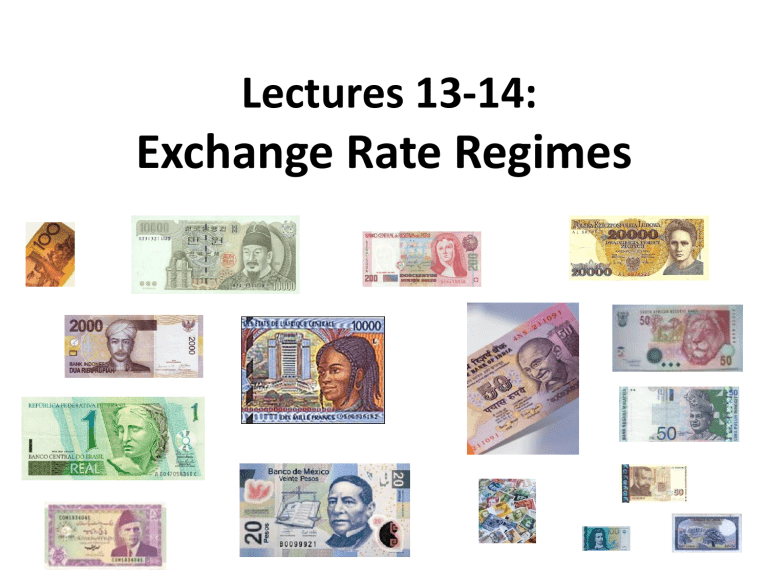
Lectures 13-14:
Exchange Rate Regimes
Topics to be covered
I. Classifying countries by exchange rate regime
II. Advantages of fixed rates
III. Advantages of floating rates
IV. Which regime dominates?
● Tests
● Optimum Currency Areas
V. Additional factors for developing countries
• Emigrants ’ remittances
• Financial development
• Terms-of-trade shocks.
VI. Intermediate regimes & the corners hypothesis
Appendices
Professor Jeffrey Frankel
Continuum of exchange rate regimes:
From flexible to rigid
1) Free float
FLEXIBLE CORNER
2) Managed float
INTERMEDIATE REGIMES
3) Target zone/band 4) Basket peg
5) Crawling peg 6) Adjustable peg
7) Currency board
9) Monetary union
FIXED CORNER
8) Dollarization
Trends in distribution of EM exchange rate regimes
• 1973-1985 – Many abandoned fixed exchange rates
• 1986-94 – Exchange rate-based stabilization programs
• 1990s -- Corners Hypothesis: countries move to either hard peg or free float
• Since 2001 -- The rise of the “managed float” category.
Distribution of
Exchange Rate
Regimes in Emerging
Markets, 1980-2011
(percent of total) }
Ghosh, Ostry & Qureshi,
2013,
“Exchange Rate
Management and Crisis
Susceptibility: A Reassessment,”
IMF ARC , Nov..
De jure regime
de facto
as is by now well-known
• Many countries that say they float, in fact intervene heavily in the foreign exchange market . [1]
• Many countries that say they fix, in fact devalue when trouble arises . [2]
• Many countries that say they target a basket of major currencies in fact fiddle with the weights . [3]
[1] “Fear of floating” -Calvo & Reinhart (2001, 2002); Reinhart (2000).
[2] “The mirage of fixed exchange rates” -Obstfeld & Rogoff (1995).
[3] Parameters kept secret -Frankel, Schmukler & Servén ( 2000).
One statistical approach to ascertaining de facto regimes:
Var (exchange rate) vs. Var (reserves).
• Calvo & Reinhart (2002) note that many countries that de jure say they float in fact have a lower Var ( Δ e) relative to Var ( Δ Res) than many that say they fix!
• Levy-Yeyati & Sturzenegger (2005) classify all countries based on variability of Δ e vs. variability of Δ Res.
The de facto schemes do not agree
• That de facto schemes to classify exchange rate regimes differ from the IMF’s previous de jure classification is by now well-known.
• It is less well-known that the de facto schemes also do not agree with each other !
Correlations Among Regime Classification Schemes
IMF
IMF GGW LY-S R-R
1.00
(100.0)
GGW
0.60
(55.1)
1.00
(100.0)
LY-S
0.28
(41.0)
0.13
(35.3)
1.00
(100.0)
R-R
0.33
(55.1
)
0.34
(35.2)
0.41
(45.3)
1.00
(100.0)
(Frequency of outright coincidence, in %, given in parenthesis.)
GGW =Ghosh, Gulde & Wolf. LY-S = Levy-Yeyati & Sturzenegger. R-R = Reinhart & Rogoff
Sample: 47 countries.
From Frankel, ADB, 2004.
Table 3, prepared by M. Halac & S.Schmukler.
Professor Jeffrey Frankel
II. Advantages of fixed rates
1) Encourage trade <= lower exchange risk.
• True, in theory, can hedge risk.
But costs of hedging: missing markets, transactions costs, and risk premia .
• Empirical: Exchange rate volatility ↑ => trade ↓ ?
Time-series evidence showed little effect. But more in:
- Cross-section evidence, especially small & less developed countries.
- Currency unions: Rose
(2000).
Professor Jeffrey Frankel
The Rose finding
• Rose
(2000) -the boost to bilateral trade from currency unions is:
– significant,
– ≈ FTAs, &
– larger (2- or 3-fold) than had been previously thought.
• Many others have advanced critiques of Rose research.
– Re: sheer magnitude
• endogeneity,
• small countries,
• missing variables.
– Estimated magnitudes are often smaller, but the basic finding has withstood perturbations and replications remarkably well. ii/
• Some developing countries seeking regional integration talk of following Europe’s lead, though plans merit skepticism.
[ii] E.g., Rose & van Wincoop (2001); Tenreyro & Barro (2003). Survey: Baldwin (2006)
Advantages of fixed rates, cont.
2) Encourage investment
<= cut currency premium out of interest rates
3) Provide nominal anchor for monetary policy
• Barro-Gordon model of time-consistent inflation-fighting
• But which anchor? Exchange rate target vs. Alternatives
4) Avoid competitive depreciation (“currency wars”)
5) Avoid speculative bubbles that afflict floating.
(vs. if variability is fundamental real exchange rate risk, it will just pop up in prices instead of nominal exchange rates).
III. Advantages of floating rates
1. Monetary independence
2. Automatic adjustment to trade shocks
3. Retain seigniorage
4. Retain Lender of Last Resort ability
5. Avoiding crashes that hit pegged rates.
(This is an advantage especially if origin of speculative attacks is multiple equilibria, not fundamentals.)
Professor Jeffrey Frankel
IV. Which dominate: advantages of fixing or advantages of floating?
Performance by category is inconclusive.
• To over-simplify findings of 3 studies:
– Ghosh, Gulde & Wolf: hard pegs work best
– Sturzenegger & Levy-Yeyati: floats perform best
– Reinhart-Rogoff: limited flexibility is best !
• Why the different answers?
– The de facto schemes do not correspond to each other.
– Conditioning factors (beyond, e.g., rich vs. poor).
Professor Jeffrey Frankel
Which dominate: advantages of fixing or advantages of floating?
Answer depends on circumstances, of course:
No one exchange rate regime is right for all countries or all times.
• Traditional criteria for choosing - Optimum Currency Area.
Focus is on trade and stabilization of business cycle.
• 1990s criteria for choosing –
Focus is on financial markets and stabilization of speculation.
Optimum Currency Area Theory (OCA)
Broad definition: An optimum currency area is a region that should have its own currency and own monetary policy.
This definition can be given more content:
An OCA can be defined as: a region that is neither so small & open that it would be better off pegging its currency to a neighbor, nor so large & heterogenious that it would be better off splitting into sub-regions with different currencies.
Professor Jeffrey Frankel
Optimum Currency Area criteria for giving up currency independence:
• Small size and openness
– because then advantages of fixing are large.
• Symmetry of shocks
– because then giving up monetary independence is a small loss.
• Labor mobility
– because then it is possible to adjust to shocks even without ability to expand money, cut interest rates or devalue.
• Fiscal transfers in a federal system
– because then consumption is cushioned in a downturn.
Professor Jeffrey Frankel
The endogeneity of the OCA criteria
Endogeneity of OCA criteria:
• Bilateral trade responds positively to currency union
-- Rose (2000).
• A country pair’s cyclical correlation rises too
(rather than falling, as under Eichengreen-Krugman hypothesis).
• Implication: members of a monetary union may meet OCA criteria better ex post than ex ante
-- Frankel & Rose (1996).
Professor Jeffrey Frankel
Popularity in 1990s of institutionally-fixed corner
• currency boards
(e.g., Hong Kong, 1983- ; Lithuania, 1994- ;
Argentina, 1991-2001; Bulgaria, 1997- ;
Estonia 1992-2011; Bosnia, 1998- ; …)
• dollarization
( e.g, Panama, El Salvador, Ecuador)
• monetary union
( e.g., EMU, 1999)
1990’s criteria for the firm-fix corner suiting candidates for currency boards or union (e.g. Calvo)
Regarding credibility:
• a desperate need to import monetary stability, due to:
– history of hyperinflation,
– absence of credible public institutions,
– location in a dangerous neighborhood, or
– large exposure to nervous international investors
• a desire for close integration with a particular neighbor or trading partner
Regarding other “initial conditions”:
• an already-high level of private dollarization
• high pass-through to import prices
• access to an adequate level of reserves
• the rule of law.
V. Three additional considerations,
particularly relevant to developing countries
• (i) Emigrants’ remittances
• (ii) Level of financial development
• (iii) Supply shocks and external terms of trade shocks
I would like to add to the traditional OCA list:
Cyclically-stabilizing emigrants’ remittances.
• If country S has sent immigrants to country H, are their remittances correlated with the differential in growth or employment in S versus H?
• Apparently yes.
(Frankel, “Are Bilateral Remittances Countercyclical?” 2011 )
• This strengthens the case for S pegging to H.
• Why? It helps stabilize the current account even when S has given up ability to devalue.
(ii) Level of financial development
• Aghion, Bacchetta, Ranciere & Rogoff
(2005)
– Fixed rates are better for countries at low levels of financial development: markets are thin.
– When financial markets develop, exchange flexibility becomes more attractive.
• Estimated threshold: Private Credit/GDP > 40%.
• Husain, Mody & Rogoff
(2005)
For richer & more financially developed countries, flexible rates work better
– in the sense of being more durable
– & delivering higher growth without inflation.
(iii) External Shocks
• An old wisdom regarding the source of shocks:
– Fixed rates work best if shocks are mostly internal demand shocks -- especially monetary;
– floating rates work best if shocks tend to be real shocks -- especially external terms of trade.
Terms-of-trade variability
• Prices of crude oil and other agricultural & mineral commodities hit record highs in 2008 & 2011.
• => Favorable terms of trade shocks for some
(oil producers, such as Mideast, Africa, Latin America);
• => Unfavorable terms of trade shock for others
(oil importers such as Korea).
• Textbook theory says a country where trade shocks dominate should accommodate by floating.
• Confirmed empirically:
– Developing countries facing terms of trade shocks do better with flexible exchange rates than fixed exchange rates.
– Broda (2004 ),
Edwards & L.Yeyati
(2005), Rafiq (2011), and Céspedes & Velasco (2012)
Céspedes & Velasco (Nov.2012) NBER WP 18569
“Macroeconomic Performance During Commodity Price Booms & Busts”
** Statistically significant at 5% level.
Constant term not reported.
(t-statistics in parentheses.)
Across 107 major commodity boom-bust cycles, output loss is bigger the bigger is the commodity price change & the smaller is exchange rate flexibility.
25
VI. Intermediate exchange rate regimes
and the corners hypothesis
Intermediate regimes
• target zone (band)
•Krugman-ERM type (with nominal anchor)
•Bergsten-Williamson type (FEER adjusted automatically)
• basket peg
(weights can be either transparent or secret)
• crawling peg
• pre-announced (e.g., tablita)
• indexed (to fix real exchange rate)
• adjustable peg
(escape clause, e.g., contingent on terms of trade or reserve loss)
The Corners Hypothesis
• The hypothesis: “Countries are, or should be, abandoning intermediate regimes like target zones and moving to either one corner or the other: rigid peg or free float.
Origins:
• 1992-93 ERM crises -- Eichengreen
(1994)
• Late-90’s crises in emerging markets – Fischer
(2001).
But the pendulum swung back,
• from 61% of IMF staff in 2002, to 0% in 2010.
• Many developing countries follow intermediate exchange rate regimes.
• The theoretical rationale for the corners hypothesis never was clear.
Managed float (“leaning against the wind”):
Turkey’s central bank buys lira when it depreciates, and sells when it is appreciates.
Kaushik Basu & Aristomene Varoudakis, Policy RWP 6469, World Bank, 2013,
“How to Move the Exchange Rate If You Must: The Diverse Practice of Foreign Exchange Intervention by Central Banks and a Proposal for Doing it Better” May, p. 14
In Latin America, renewed inflows in 2010 were reflected mostly as reserve accumulation in Peru, but as appreciation in Chile & Colombia . more-managed floating less-managed floating
(“more appreciation-friendly”)
Source: GS Global ECS Research
Korea & Singapore in 2010 took renewed inflows mostly in the form of reserves, while India & Malaysia took them mostly in the form of currency appreciation.
more-managed floating less-managed floating
(“more appreciation-friendly”)
Goldman Sachs Global ECS Research
The flexibility parameter can be estimated in terms of Exchange Market Pressure:
– Define
Δ EMP = Δ value of currency + Δ reserves/MB.
– Δ EMP represents shocks in currency demand.
– Flexibility can be estimated as the propensity of the central bank to let shocks show up in the price of the currency (floating) , vs. the quantity of the currency (fixed), or in between (intermediate exchange rate regime).
Distillation of technique to infer flexibility
• When a shock raises international demand for the currency, does it show up as an appreciation, or as a rise in reserves?
• EMP variable appears on the RHS of the equation.
The % rise in the value of the currency appears on the left.
– A coefficient of 0 on EMP signifies a fixed E
(no changes in the value of the currency),
– a coefficient of 1 signifies a freely floating rate
(no changes in reserves) and
– a coefficient somewhere in between indicates a correspondingly flexible/stable intermediate regime.
APPENDICES ON EXCHANGE RATE REGIMES
• Appendix 1: On the RMB
• Appendix 2: Tables comparing economic performance of different regimes
• Appendix 3: The econometrics of estimating de facto exchange rate regimes
.
• Appendix 4: IT versus alternative anchors, with volatility in commodity export prices
Appendix 1
On the RMB
Five reasons why China should move to a more flexible exchange rate regime, in its own interest
• Overheating of economy
– 2007: stock market bubble, bottlenecks, inflation 6%, price controls
– 2008-09 slowdown: loss of demand
– Back by 2010-11.
• Excessive reserves (≈ $4 trillion )
– though a useful shield against currency crises, China has enough reserves.
– Harder to sterilize the inflow over time.
(Sept. 2007).
• Attaining internal and external balance.
– To attain both, need 2 policy instruments.
– In a large country like China, the expenditure-switching policy should be the exchange rate.
– Along with expenditure-increasing policies (2009).
• Avoiding crisis:
– Experience suggests it is better to exit from a peg in good times, when the BoP is strong, than to wait until the currency is under attack.
• RMB undervalued, judged by Balassa-Samuelson criterion.
China was back in the overheating + surplus quadrant of the Swan Diagram by 2010
ED & TB>0
China
2010
BB:
External balance
CA =0
ED & TD
ES & TB>0
China
2002
ES & TD
Spending A
YY:
Internal balance
Y = 𝑌
How should changes in real exchange rate, when necessary, be achieved?
• For a very small, open economy
– advantages of keeping E fixed are large.
– Adjustment may take place via prices instead
– Example: Hong Kong.
• For a large economy like China, it makes more sense to adjust E than to adjust prices
What would new regime be?
• No need for pure float.
• China is an example of why the Corners
Hypothesis is wrong
• Band or target zone may be best
• With what as anchor?
– Advantage of dollar: simple and transparent
– Advantage of basket: better diversification
– Asia currently lacks a good anchor currency.
Appendix 2
Tables comparing economic performance of different regimes:
– Ghosh, Gulde & Wolf
– Sturzenegger & Levy-Yeyati
– Reinhart & Rogoff
Which category experienced the most rapid growth?
Ghosh, Gulde
& Wolf: currency boards
Levy-Yeyati &
Sturzenegger: floating
Reinhart & Rogoff: limited flexibility
Levy-Yeyati & Sturzenegger (2001): floats work best.
Effect of regime on growth rates, controlling for various determinants
Levy-Yeyati &
Sturzenegger (2001).
Sample: yearly observations 1974-1999.
Appendix 3:
The econometrics of estimating de facto exchange rate regimes.
• Why do the various schemes for classifying countries by de facto exchange rate regimes give such different answers?
• Synthesis of the technique for estimating the anchor and the technique for estimating the degree of exchange rate flexibility.
Schemes for de facto classification
• have themselves been divided into two classifications, viewed as:
– “mixed de jure-de facto classifications, because the self-declared regimes are adjusted by the devisers for anomalies.
”
– Vs. “pure de facto classifications because…assignment of regimes is based solely on statistical algorithms….”
-- Tavlas, Dellas & Stockman (2006).
Jay Shambaugh (2007) again finds that the de facto classification schemes tend to agree with each other even less than they agree with the de jure scheme.
Percentage agreement of methodologies to code who pegs
De
Jure
Jay S. LY-S R-R
De
Jure
100%
86% 100% Jay S.
LY-S
R-R
74%
81%
80%
82%
100%
73% 100%
Professor Jeffrey Frankel
As do Bénassy-Quéré et al
(2004)
The IMF now has its own “de facto classification”
-- but still close to official IMF one: correlation (BOR, IMF) = .76
Pure de facto classification schemes
1. Method to estimate degree of flexibility:
• Levy-Yeyati & Sturzenegger
(2005): compare variability of Δ exchange rates vs. variability of Δ reserves.
2. Method to estimate implicit basket weights:
Regress Δ value of local currency against Δ values of major currencies.
Frankel & Wei (1993, 95, 2007), Bénassy-Quéré (1999), B-Q et al (2004).
• Close fit => a peg.
• Coefficient of 1 on $ => $ peg.
Or on other currencies => basket peg.
• Example of China, post 7/2005.
3. Synthesis method:
F & Wei
(2008),
F & Xie
(2010) .
• Regress Δ value of local currency against EMP, to estimate flexibility parameter
• and against Δ values of $ and other major currencies, to estimate weights in anchor basket.
Appendix 4
IT versus alternative anchors
to take into account commodity export product prices
Fashions in international currency policy
• 1980-82: Monetarism
(target the money supply)
• 1984-1997: Fixed exchange rates
(incl. currency boards)
• 1993-2001: The corners hypothesis
• 1998-2008: Inflation targeting
(+ currency float) became the new conventional wisdom
• Among academic economists
• among central bankers
• and at the IMF
Professor Jeffrey Frankel
6 proposed nominal targets and the Achilles heel of each:
Monetarist rule
Targeted variable
M1
Vulnerability
Velocity shocks
Example
US 1982
Inflation targeting
CPI Import price shocks
Oil shocks of
1973-80, 2000-08
Nominal income targeting
Less developed countries
Gold standard
Commodity standard
Fixed exchange rate
Nominal
GDP
Price of gold
Price of agric.
& mineral
basket
$
( or
€)
Measurement problems
Vagaries of world gold market
Shocks in imported commodity
Appreciation of $
(or € )
1849 boom;
1873-96 bust
Oil shocks of
1973-80, 2000-08
1995-2001
Professor Jeffrey Frankel
Inflation Targeting has been the reigning orthodoxy.
• Flexible inflation targeting ≡
“Have a LR target for inflation, and be transparent.”
Who could disagree?
• But define IT as setting yearly CPI targets, to the exclusion of
• asset prices
• exchange rates
• export commodity prices.
• Some reexamination is warranted, in light of 2008-2011.
Professor Jeffrey Frankel
• The shocks of 2008-2012 showed disadvantages to Inflation Targeting ,
– analogously to how the EM crises of the 1994-2001 showed disadvantages of exchange rate targeting.
• One disadvantage of IT: no response to asset price bubbles.
• Another disadvantage
:
– It gives the wrong answer in case of trade shocks:
• E.g., it says to tighten money & appreciate in response to a rise in oil import prices;
• It does not allow monetary tightening
& appreciation in response to a rise in world prices of export commodities.
• That is backwards.
Professor Jeffrey Frankel
Proposal for Product Price Targeting
Intended for countries with volatile terms of trade, e.g., those specialized in commodities.
PPT
The authorities stabilize the currency in terms of an index of product prices, such as the GDP deflator,
( a basket that gives weight to prices of its commodity exports), rather than to the CPI (which gives weight to imports).
The regime combines the best of both worlds:
(i) The advantage of automatic accommodation
to terms of trade shocks, together with
(ii) the advantages of a nominal anchor.
Why is PPT better than CPI-targeting for countries with volatile terms of trade
?
PPT
Better response to adverse terms of trade shocks:
• If the $ price of the export commodity goes up,
PPT says to tighten monetary policy enough to appreciate currency.
– Right response.
(E.g., Gulf currencies in 2007-08.)
• If the $ price of imported commodity goes up,
CPI target says to tighten monetary policy enough to appreciate currency.
– Wrong response.
(E.g., oil-importers in 2007-08.)
– => CPI targeting gets it backwards.
Professor Jeffrey Frankel
Recap of Product Price Targeting
:
PPT
Target an index of domestic production prices.
[1]
The important point: include export commodities in the index and exclude import commodities, whereas the CPI does it the other way around.
[1] Frankel (2011).
Professor Jeffrey Frankel
Does floating give the same answer?
• True, commodity currencies tend to appreciate when commodity markets are strong, & vice versa
– Australian, Canadian & NZ $
(e.g., Chen & Rogoff, 2003)
– South African rand
(e.g., Frankel, 2007)
– Chilean peso and others
• But
– Some volatility under floating appears gratuitous.
– Floaters still need a nominal anchor.
Professor Jeffrey Frankel
200.000
The Rand, 1984-2006:
Fundamentals (real commodity prices, real interest differential, country risk premium, & l.e.v.) can explain the real appreciation of 2003-06
– Frankel (SAJE, 2007).
180.000
160.000
140.000
120.000
100.000
80.000
60.000
40.000
20.000
Actual vs Fitted vs. Fundamentals-
Projected Values
0.000
Q
2 1
98
4
Q
1 1
98
5
Q
4 1
98
5
Q
3 1
98
6
Q
2 1
98
7
Q
1 1
98
8
Q
4 1
98
8
Q
3 1
98
9
Q
2 1
99
0
Q
1 1
99
1
Q
4 1
99
1
Q
3 1
99
2
Q
2 1
99
3
Q
1 1
99
4
Q
4 1
99
4
Q
3 1
99
5
Q
2 1
99
6
Q
1 1
99
7
Q
4 1
99
7
Q
3 1
99
8
Q
2 1
99
9
Q
1 2
00
0
Q
4 2
00
0
Q
3 2
00
1
Q
2 2
00
2
Q
1 2
00
3
Q
4 2
00
3
Q
3 2
00
4
Q
2 2
00
5
Q
1 2
00
6
RERICPIactual RERICPIFitted RERICPIProjected
Professor Jeffrey Frankel
In practice, most IT proponents agree central banks should not tighten to offset oil price shocks
• They want focus on core CPI, excluding food & energy.
• But
– food & energy ≠ all supply shocks.
– Use of core CPI sacrifices some credibility:
• If core CPI is the explicit goal ex ante, the public feels confused.
• If it is an excuse for missing targets ex post, the public feels tricked.
– The threat to credibility is especially strong where there are historical grounds for believing that government officials fiddle with the CPI for political purposes.
– Perhaps for that reason, IT central banks apparently
do respond to oil shocks by tightening/appreciating ….
